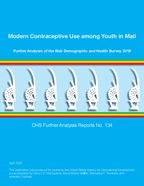There is no printed copy available to order.
Abstract:
Mali has a large youth population, making up
44% of women of reproductive age, and
ambitious family planning goals. Given the
potential to contribute to the country’s
family planning objectives, this study
examines patterns of modern contraception
among youth using data from 10,519 women and
1,478 episodes of contraceptive use from the
2018 Mali Demographic and Health Survey.
Across multiple outcomes, the study compares
young women with their older counterparts and
married women with unmarried, sexually active
women who are disproportionately young.
Unmet need for modern contraception is lower
among young, married women than older,
married women. Unmet need is very high for
unmarried women, regardless of age, and is
almost double that among married women.
Women age 15-24 are less likely to use modern
contraception when compared with older women,
but that unmarried, sexually active women are
more likely than married women to use modern
contraception. Contraceptive discontinuation
rates are higher for young women than for
older women, and this finding holds across
all modern methods of contraception. About
half of all discontinuation among young women
is due to reduced need, while half is
discontinuation while still in need.
Discontinuation because pregnancy is desired
is more common among young women than older
women.
The method mix varies by age and marital
status. Implants and injectables contribute a
larger share to the method mix among young
women than older women. Implants contribute a
larger share while pills a smaller share of
contraceptive use among unmarried women
(regardless of sexual activity) than among
married women.
The source of contraception is largely
determined by the method used, and not by age
or marital status of the user. However, both
young pill users and unmarried injectable
users avoid community health
centres/dispensaries, and prefer private
pharmacies (pills and injectables), other
private sources (pills), and government
hospitals/reference health centres
(injectables).
These findings suggest that investment in
supply-side and demand-side interventions
that promote and sustain contraceptive use
among current contraceptive users and
potential new users, alike, and that reduce
unmet need are warranted.
